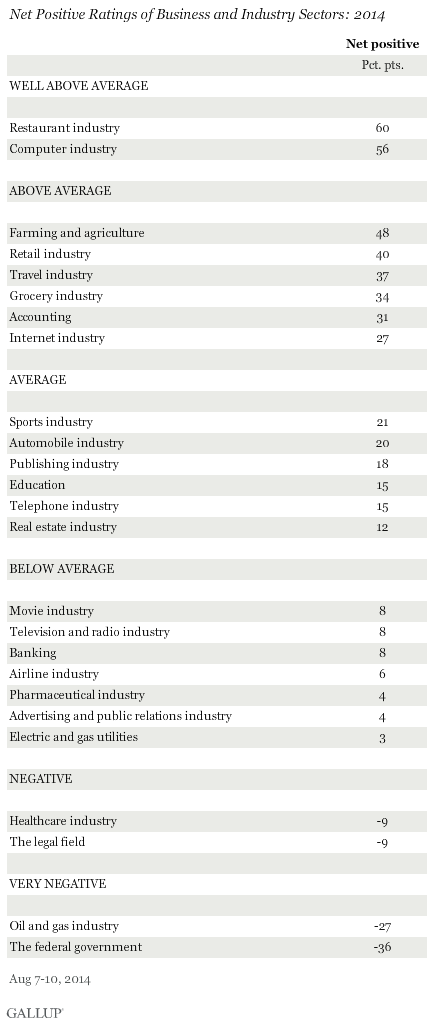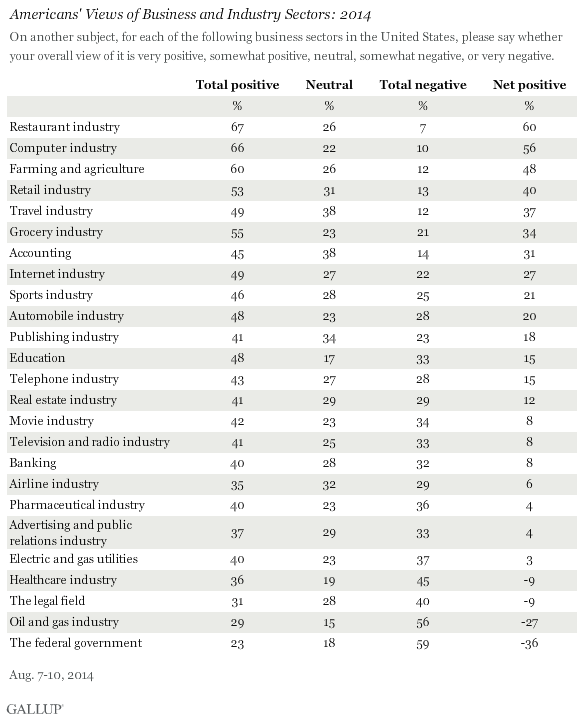PRINCETON, NJ -- Americans' views of 24 business and industry sectors continue to grow more positive after falling precipitously in 2008 during the Great Recession. The average net-positive rating of the 24 sectors is now +18, up from -1 in 2008, and the highest since 2003.

These results are based on Gallup's annual Work and Education poll, conducted Aug. 7-10. Each year since 2001, Gallup has asked Americans to rate 24 different business sectors and industries on a scale ranging from "very positive" to "very negative." The net-positive ratings are the difference between the positive and negative ratings for each industry. Ratings of "the federal government," included in the list since 2003, are not included in the yearly averages.
Americans' views of individual business and industry sectors included in the average have varied over the years, and future articles on Gallup.com will explore these differences. But, overall, the trend in the combined average clearly shows that these business sectors have steadily recovered from the blow they took in 2008. Business and industry -- at least as represented by these industries -- have returned to the relative good graces of the American public. This increase since 2008 is similar to the general recovery in other Gallup measures, including economic confidence, job creation, and Payroll to Population and unemployment.
Restaurant Industry Has Top Image; Oil and Gas, Federal Gov't, the Worst
Americans have widely differing views of the specific sectors included in Gallup's annual list. (The complete ratings are on page 2.) The relative rank order of the sectors stays fairly consistent from year to year, particularly for the sectors rated best and worst.

The two "well above average" sectors -- the restaurant and computer industries -- are the only sectors with net-positive scores higher than 50. At the other end of the scale, three sectors are rated "negative" or "very negative": the healthcare industry, the legal field, and -- at the bottom of the list -- the oil and gas industry. The federal government, not a business sector or industry per se, but included on this list in recent years for comparison purposes, is dead last with a net-positive image of -36.
This rating system taps into Americans' initial top-of-mind reactions to these industries, much as favorable/unfavorable ratings measure general feelings about individual politicians. Americans' ratings of these business and industry sectors thus may reflect a wide variety of factors. In addition to the economy's overall health, these can include people's personal involvement with the industries, news stories about real-world incidents involving the industries, the types of services each industry provides, the costs of these services, legal issues involving the industries, and general perceptions about how well each is doing its job.
The perennially negative image of the oil and gas industry, for example, may reflect concerns about the effect this industry has on the environment, as well as about the sometimes seemingly unexplainable increases in gasoline prices at times when the industry is making high levels of profits. The positive image of the restaurant industry could reflect the wide variety of restaurants available for the public to choose from, particularly in regard to cost, and that dining out is often associated with pleasure and friends or family.
The negative image of the healthcare industry could reflect the reaction some of the public has had to the controversial Affordable Care Act, along with general concerns about steadily increasing healthcare premiums and costs. Gallup's honesty and ethics of professions ratings show that healthcare professionals per se rate well, suggesting the relative contempt is focused more on the healthcare system than on the people involved. That the legal profession scores low is no surprise given the generally low rating of the honesty and ethics of lawyers in the same survey.
The "computer" industry does significantly better than the Internet industry, suggesting that Americans differentiate between the makers of computer products and the Internet, particularly given the recent revelations of invasions of privacy and breaches of data and email accounts.
Implications
Americans' images of various business and industry sectors matter for several reasons, including the effect such images have on consumers' decisions about spending money in these sectors. A positive or negative industry image can also affect investment decisions, and indirectly affect decisions on the passage of regulatory legislation, taxation, and government rules that in turn can affect the operating environment of a business.
The oil and gas industry's relatively negative image is apparently no secret to that industry, as shown by the television and print and online advertising campaigns designed to improve British Petroleum's image after the Gulf oil spill in 2010. If the Internet industry's image continues to deteriorate in coming years because of concerns about privacy and hacking, the industry may attempt to burnish its reputation, although Americans are still on balance quite positive toward it, which is not the case for oil and gas.
Overall, however, the continuing six-year recovery of the images of major businesses is good news for the business sector in the U.S., and suggests that improving economic conditions are making Americans feel more positive about the businesses that are the engine of the nation's economy.
Survey Methods
Results for the latest Gallup Work and Education poll are based on telephone interviews conducted Aug. 7-10, 2014, with a random sample of 1,032 adults, aged 18 and older, living in all 50 U.S. states and the District of Columbia.
For results based on the total sample of national adults, the margin of sampling error is ±4 percentage points at the 95% confidence level.
Interviews are conducted with respondents on landline telephones and cellular phones, with interviews conducted in Spanish for respondents who are primarily Spanish-speaking. Each sample of national adults includes a minimum quota of 50% cellphone respondents and 50% landline respondents, with additional minimum quotas by time zone within region. Landline and cellular telephone numbers are selected using random-digit-dial methods. Landline respondents are chosen at random within each household on the basis of which member had the most recent birthday.
Samples are weighted to correct for unequal selection probability, nonresponse, and double coverage of landline and cell users in the two sampling frames. They are also weighted to match the national demographics of gender, age, race, Hispanic ethnicity, education, region, population density, and phone status (cellphone only/landline only/both, and cellphone mostly). Demographic weighting targets are based on the most recent Current Population Survey figures for the aged 18 and older U.S. population. Phone status targets are based on the most recent National Health Interview Survey. Population density targets are based on the most recent U.S. census. All reported margins of sampling error include the computed design effects for weighting.
In addition to sampling error, question wording and practical difficulties in conducting surveys can introduce error or bias into the findings of public opinion polls.
View survey methodology, complete question responses, and trends.
For more details on Gallup's polling methodology, visit www.gallup.com.

